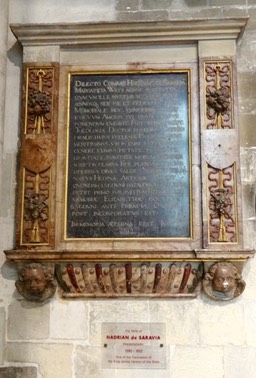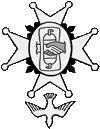THE MID 16TH CENTURY, many French-speaking Protestant Walloons and Dutch-speaking Flemings came to England to escape the turmoil of warfare and religious persecution by the Catholic Inquisition in their Netherlands homeland.
The refugees entered England through various Channel ports and many went thence to London. The small Cinque Port of Sandwich took in large numbers, both groups founding their own churches. Soon the town was overflowing and the Walloons were permitted by the Crown to move on to Canterbury. The city was pleased to welcome them; it had many empty houses to offer, following the destruction of Becket’s tomb and the end of the pilgrimages which had brought so much wealth to the city through the middle ages.
In 1575, the strangers (as they were called) were allowed to gather for worship at the church of St Alphege opposite the Archbishop’s Palace, but within a year this became too small and they were granted use of the Western Crypt of the cathedral.
Here they held their services regularly and the governing body of their church, known as the consistory, met frequently to decide policy and to supervise the congregation.
The immigrants had come mainly from the area around Lille, Valenciennes, Tournai and Armentières and the small towns along the valley of the river Lys, near the French border. This area, where Reformism was strong, had been renowned since mediaeval times for its sophisticated cloth manufactures. So it was that the Canterbury Walloons were engaged largely in the weaving trade.
In Canterbury and the surrounding villages they provided much welcome employment for local women and children engaged in spinning, the cloth being woven on looms in the Walloons’ own houses. There were many varieties of these ‘new draperies’ using wool of fine quality from nearby Romney Marsh, together with silk and linen threads.
The finished cloth was sent chiefly to London or exported; merchants and master weavers flourished. Upon arrival, the strangers had made an agreement with the city authorities that they would maintain their own orphans and widows, their elderly and their sick. The English poor law would not help them. They paid their own ministers’ wages, rent for the cathedral crypt and for its repair. The elders and deacons visited the flock regularly, collecting money and distributing communion tokens, clothing and funds.
At this troubled time many refugees (‘passants’) passed through the city and were given money to go on to London or to return to the Netherlands seeking relatives or checking on their property. The Walloon church consistory was made up of a minister, about ten elders (usually masters in the cloth trade) and eight deacons (two to each of the four quartiers into which they had divided the city).
They met regularly, dealing with misdemeanours, often carousing in the many inns and ale houses. Soon they set up a lay body the ‘hommes politiques’ who would exact fines and liaise with the city council — the ‘burgmote’.
The first regularly appointed Minister was Antoine Lescaillet who had come to Canterbury via Sandwich. He remained as minister until, falling ill, he was assisted and then replaced by Samuelle Le Chevalier, a younger man sent by the London church. The energetic and outspoken Le Chevalier was succeeded by the redoubtable pair Delmé and Bultéel, of whom more later.
Plague hit the city severely in 1595; tents were erected in the Dane John (now a beautiful garden) to isolate the victims. Proportionately the Walloons fared worse than the English, losing about 10 per cent of their number, half of them children.

The most eminent conformist Walloons have memorials in the cathedral, notably Richard Colfe (died 1613) Canon and Archdeacon and Adrian de Saravia (died 1612) canon of the cathedral, a translator of the King James Authorised Version of the Bible and co-author of the Confessio Belgica.
Joining the Walloons were many Huguenots, Protestant refugees from northern France, fleeing the long wars of religion and the accompanying persecution which, though widespread in France, tended usually at that time to be less severe than in the Netherlands.
By the end of the century, the community had grown from the original 25 families to more than 2,500 inhabitants in a population totalling between 6,000 and 9,000. The size of the congregation fluctuated, falling through natural causes – assimilation and death – and rising in response to the waves of repression and war in the Netherlands and France.
The 17th century was very different.
© Margaret Fisher 1992
